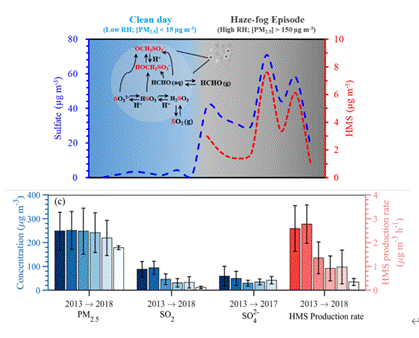Recently, a research work titled “Quantitative determination of Hydroxymethanesulfonate (HMS) using Ion Chromatography and UHPLC-LTQ-Orbitrap Mass Spectrometry: A missing source of sulfur during haze episodes in Beijing” was published in Environmental Science & Technology Letters as the journal cover article (Volume 7, Issue 10, 2020). The authors have quantified the abundance of HMS (molecular formula: CH2(OH)SO3H) in fine particles by two developed analytical methods, and give a detailed discussion on the HMS formation mechanism during haze-fog episodes with a kinetic model.

The study was selected to be featured as the Cover Article of the Journal of Environmental Science & Technology Letters in October 2020
Sulfur-containing compounds present in atmospheric particles can be classified into two categories: inorganic sulfur and organic sulfur compounds. Sulfate, the major inorganic hydrophilic component of fine particles (PM2.5) and multiple-phase oxidation product from SO2, was the key trigger of heavy pollution episodes. However, current air quality models fail to reproduce elevated sulfate levels during extreme haze event. Several mechanisms for S(IV) oxidation are still under consideration to account for great discrepancy between modeled and observed sulfate. Recently, HMS has been suggested to be an important source of particulate sulfur during haze events, the main challenge regarding HMS measurements is that it has been suggested to be misidentified as S(IV) or S(VI) compounds, mainly sulfate, using ion chromatography (IC) and/or mass spectrometry (MS) techniques. An overlap of similar fragmentation patterns between sulfate, HMS and other organosulfur species and a lack of unique marker ions for HMS in AMS spectra make it more challenging to distinguish them. The misidentification between sulfate, organosulfates and HMS would pose a problem on quantitative determination of sulfur-containing compounds and further elucidation of atmospheric sulfur chemistry.
HMS, one of the most important organosulfur compounds with low molecular weight, is the product of formaldehyde (HCHO) and dissolved sulfite/bisulfite. HMS, which is highly resistant to oxidation, is an important S(IV) species and an effective tracer of atmospheric aqueous phase chemistry near combustion sources, or in polluted and humid urban atmosphere. It is therefore of high interest to understand the role of HMS in atmospheric sulfur chemistry. In the study, the authors used ultrahigh-performance liquid chromatography (UHPLC)-LTQ-Orbitrap mass spectrometry to determine the concentration of HMS in fine particles, and make an improvement to the pretreatment processes and chromatography conditions to obtain an optimum separation efficiency between HMS and sulfate peaks. The IC method with the optimum chromatographic conditions provides a rapid and feasible technique for the simultaneous determination of sulfate, HMS and other major inorganic anions and avoids problems of misidentification resulting from ambiguities and peak distortions. The comparison of the two technique, ion chromatography and UHPLC-LTQ-Orbitrap MS, give a more reliable information for the accurate chemical measurements of HMS in aerosol samples. In addition, a box model incorporating the kinetic formation of HMS with emphasis on pH dependence is also presented.
This study, to some extent, fills the gap of missing source of atmospheric organic sulfur components, and highlights that the HCHO is also a limiting factor in the atmospheric sulfur chemistry during haze events. A deep understanding on the formation mechanism between S(IV) species and HMS is helpful to further simulation of atmospheric sulfur cycle.
Lianfang Wei, the postdoctoral fellow from Institute of Atmospheric Physics, Chinese Academy of Sciences, is the first author of the publication. Professor Pingqing Fu at Tianjin University and Professor Yu-qi Feng at Wuhan University are the co-corresponding authors.

Chart above:The characteristics of sulfate and HMS in atmospheric aerosols in Beijing;Chart blow:Average online PM2.5, SO2, offline measured sulfate in PM2.5 and predicted production rate of HMS under haze condition ([PM2.5] ≥ 150 μg m−3) in wintertime Beijing from 2013 to 2018.
By the School of Earth System Science
Editor: Eva Yin






